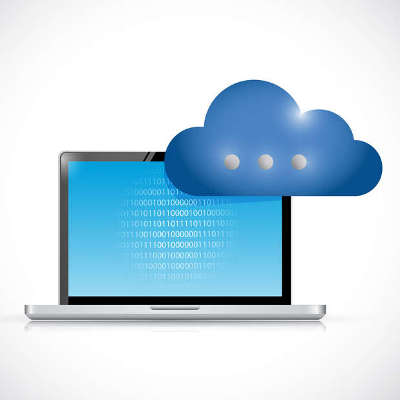You Can Save Money By Hosting Data in the Cloud (Depending How You Do It)

Cloud computing is taking the business world by storm. Despite this, not every organization has made the switch. While every company that hasn’t yet migrated to the cloud has their reasons, one big reason often tops the list: the perceived lack of cost savings. Thanks to a new study, this perception is now proven to be inaccurate.
The study was performed by John Burke, analyst and CIO of Nemertes Research. In it, he looked at real-world scenarios of enterprises hosting their workloads in-house vs in the cloud. Though his findings have yet to be finalized, he collected enough information to provide InformationWeek with a formula that businesses can use as an indicator of predictable cost savings to be found in the cloud. The formula is as follows: “With an IT staff person as the unit of cost, the enterprise data center workload costs $ 23 per IT staffer compared to $ 18 of IT staff expense for a workload in the cloud.”
Suffice to say, the computing needs of every organization are unique, so this formula may not apply exactly to your own business model. We should also note how past attempts to get a lockdown on a predictable cost savings formula for cloud computing have been difficult. This is due in part to the pricing models varying between cloud providers, especially when it comes to the different combination of resources utilized by SMBs.
Despite such variations, Burke has confidence in his preliminary findings. Delving further into the study, Burke found that the greatest cost savings come from workloads requiring more scalability due to extremes in traffic. Compared to workloads that are more predictable, Burke says that these models “may or may not be less expensive to run in the cloud.”
For companies looking to maximize the savings found in the cloud, Burke has some advice. “Don’t expect to save money with the cloud unless you’re willing to change what you’re doing with the cloud – re-architect applications or develop cloud-native ones.” To put it plainly, organizations willing to refactor or re-engineer their workload have the most to gain by migrating to the cloud. An example of such a move is using a cloud database service instead of setting up a database virtual server to run the service continuously.
Therefore, business owners looking to find significant savings by migrating to the cloud need to tailor their expectations accordingly. Simply migrating a workload to the cloud in an effort to duplicate its operational characteristics, though beneficial in many ways, won’t yield your budget much in the way of cost savings. To take full advantage of how the cloud can save your business money, you’re going to want to work with an IT professional to find ways to re-engineer the workloads of your current operations. This will take extra time and resources for the technician to familiarize themselves with your company’s IT system so they can enact the changes needed. Although, seeing as such changes will result in improved efficiency and cost savings, it’s a move that’s well worth the expense.
Are you looking to get the maximum savings from your company’s cloud computing solutions? Call Catalyst Technology Group today at (317) 705-0333 to find out how.
Tip of the Week: How to Get Around YouTube’s Restrictions and Play Videos on Repeat

Anyone who has taken a stroll through YouTube knows that people love to upload music to the video sharing website. However, YouTube doesn’t inherently offer a built-in repeat function for playing videos, so if you want to watch a video multiple times, you’re out of the loop. Fortunately, there are numerous online services that allow you to repeat videos.
This repeat feature has practical business purposes as well. It’s perfect for when you want to loop your company video at a trade show booth, storefront, or lobby.
First, you want to find the YouTube video that you want to loop. Copy and paste its URL into a new tab, but don’t hit Enter just yet.
Next, delete the protocol that is at the beginning of the URL. This is the “https://” portion of the link. Now, type the word “repeat” into the URL right after the word “youtube.” Keep the rest of the link intact so that the website knows which video you want to be repeated. The end result should look something like this: youtuberepeat.com/watch/(random letters and numbers).
This will redirect you to a site called ListenOnRepeat.com, which will let you play any YouTube video on repeat. This website will even track how many times the video has started over, which can be a great way to see how long you can listen to the same thing over and over again.
One other way that you can do this is by using Infinite Looper, which can let you play YouTube videos on a loop. In particular, Infinite Looper lets you loop specific sections of the video. So, if you like a specific part of a video, you can just play that over… and over… and over again.
You can find this service on http://www.infinitelooper.com/
For more great tips and tricks, reach out to us at (317) 705-0333 and subscribe to our blog.
Thunder Follows Lightning, And So Does Scorched Technology

With the return of warmer weather to much of the world, thunderstorms and lightning strikes are more common–and more problematic–than before. All it takes is a bit of rotten luck to find yourself on the receiving end of a lightning storm, and often times unprepared businesses will find themselves unable to recover from the damages. How can your organization mitigate the threat of damage caused by thunderstorms and fires associated with them?
Lightning can cause trouble for electrical appliances, in particular, and any machines that you rely on for business practices, including computers and other networking components. The insurance industry estimates that around 6.5 percent of all claims have to do with lightning storms. Power surges and fires can result from them, both of which can damage critical technology systems and your building’s physical infrastructure.
Here are two ways that your organization can defend against lightning storms and the damages brought about by them.
Uninterruptible Power Supplies (UPS)
UPS devices can help your business keep damage from lightning storms to a minimum. This is because uninterruptable power supplies regulate the power flowing out of outlets and into your technology, which keeps them from getting hit from power surges. In fact, many surge protectors even guarantee up to a certain amount of damage in monetary value if their products don’t work as intended.
Since a UPS can also ensure that your technology has the time to properly shut down following a loss of power, they are invaluable to have in your office. This keeps you from losing progress or losing data outright. Plus, you’ll suffer less damage to your hardware, which is always a plus.
Backup and Disaster Recovery (BDR)
In order to keep your business from losing data during a disaster, you need some form of data backup and recovery. The best way to approach backup and recovery is with a BDR solution that can take multiple backups a day, offer a quick restoration time, and provide off-site storage for your data.
The best way to fight back against natural occurrences like electrical storms is to implement a business continuity plan that mitigates damages caused by situations beyond your control. Remember, the best way to defend against unforeseen circumstances is to plan for them. If you plan for the worst, you can be prepared to face it should it rear its ugly head. To learn more about business continuity, reach out to us at (317) 705-0333.
With Great Power Comes a Greater Security Risk, Study Finds

Every user on your network adds an additional level of risk, whether it be risk of user error, making a mistake that causes a data breach, or worse. One would assume that a company’s biggest risk would come from an untrained employee that disregards security policies, but surprisingly, that’s not always the case. Research has shown that a company’s CEO along with the rest of its C-level executives are the greatest security risk.
There are multiple factors that go into this. Take for instance the sheer amount of sensitive data that a CEO has access to. Whereas an average employee may just have access to data pertaining to their job or their department, a CEO generally has carte blanche to access any data they desire.
Then there’s the fact that CEOs typically have a poor work-life balance. This means that they put in way more hours than the average employee. You don’t have to be an expert in risk assessment to understand that a user accessing a company’s network 60, 70, or even 80 hours each week is a far greater risk than a user that only accesses the network 40 hours per week.
Both of these factors contribute to another reason why CEOs make for such a large security risk: the mobile devices they carry. In an effort to always be connected to the office, a CEO’s mobile device may have unfettered access to company records and sensitive information–more so than an average employee’s personal device.
In the case of an employee that has separate mobile devices for their work and personal life (often a luxury that CEOs can’t enjoy), the risk of data leakage or a breach resulting from the device getting lost or stolen goes down dramatically. Alternatively, CEOs aren’t restricted to the office and this mobility increases the risk of being hacked outside the office, especially when it comes to using their mobile devices in venues that offer public Wi-Fi, like coffee shops, cafés, conference centers, airports, etc. Hackers know this and they go to great lengths to make public Wi-Fi hotspots traps for unsuspecting users. This is why CEOs should be wary about accessing public Wi-Fi, and why it’s preferable that CEOs even avoid public Wi-Fi altogether (unless you are using a secure VPN to access all of your data).
A 2017 security report by iPass confirms this risk of cyber-attacks at popular Wi-Fi hotspots. The report ranks the riskiest public venues as follows.
- Coffee shops and cafés, 42 percent.
- Airports, 30 percent.
- Hotels, 16 percent.
- Exhibition centers, 7 percent.
- Airplanes, 4 percent.
How much time do your company’s C-level executives spend doing business from these locations? The more business that’s done using Wi-Fi at these locations, the more of a risk an executive or even a mobile employee is to your organization.
Finally, CEOs are in a category unto themselves when it comes to another risk: CEO whaling scams. This is where scammers spend time researching the lives and motivations of CEOs so they can specifically target them with scams from a variety of sources, including email, phone calls, traditional paper mailings, and whatever other means they can use to get in contact with a CEO. This is an extremely dangerous scam because, unlike traditional scams like spam messages where the same message gets sent to thousands of people (and it’s often easy to recognize that it’s a scam), a CEO whaling correspondence is personalized to play on a CEO’s deepest fears and desires. For the scammers that go after CEOs like this, the effort is worth the time investment, due to the simple fact that CEOs make for such lucrative targets.
So, there you have it. CEOs are one of a company’s biggest security risks. For your business, this means you’ve got to take additional measures to ensure the protection of your C-level executives. Generally speaking, the same security plan and policies that work for the average employee won’t cut it for an executive, which is something you need to take into account when coming up with your company’s security and BYOD policy. Need help protecting your company’s data? Give Catalyst Technology Group a call today at (317) 705-0333.
4 Steps to Getting Started With Digital Transformation

Smart business owners always look for ways to improve the way their organization functions. Digital transformation is one of these ways, as it allows for organizations to use technology to minimize waste and enhance workflow. To help you with digital transformation, we’ll walk you through what it is and how it works.
Digital Transformation in the Wild
One example of how digital transformation works can be seen in McDonald’s. In an attempt to streamline order processing, McDonald’s is using kiosks at some locations to reduce the time it takes to order and deliver food. These kiosks allow hungry customers to pay with a variety of methods, including Apple pay. Other food chains have already implemented features like online ordering to provide additional convenience to customers. Both of these examples are ways in which digital transformation has allowed modern businesses to improve the way they function in a substantial way.
Digital transformation allows businesses to create a unified technology platform that changes or completely revamps the way operations are carried out. It’s basically a way to improve your company’s operations by using data, analytics, and other digital tools. Digital transformation lets businesses adapt to new trends and capture new opportunities.
All of this might seem simple on paper, but the implementation process has more than a few roadblocks to watch out for. If your business wants to implement digital transformation, here are a few steps to get started.
Consider the Scope
There’s a lot of work involved in the implementation of digital transformation. Therefore, it’s crucial that you don’t underestimate the scope of this process, as you could potentially end up in a situation where you’re out of time and resources. End-to-end implementation requires a careful analysis of just about every possibility. To meet this goal, you’ll need to rely on your department managers and C-suite staff to better understand how technology affects specific parts of your organization. Once these processes have been defined and outlined, you can move toward creating a unified platform to best match them.
Start From the Beginning
While you might want to digitize your current infrastructure as soon as possible, it’s important that you consider, first and foremost, your current technology needs. The reasoning for this is simple–it’s possible (even likely) that your operational infrastructure is outdated in at least some capacity. Therefore, you should invest in new solutions that recreate your current business processes, as well as reimagines them in better, more efficient ways. In this case, you’re taking advantage of improving operations to an entirely different level.
Build Transformation Alongside Production
It’s likely that the solutions and processes you implement could disrupt your current operations, so you want to first make sure that digital transformation is possible without completely hampering your current infrastructure. To this end, you need proactive migration, along with a thorough testing procedure to ensure that implementation doesn’t hinder production. Virtualization and cloud computing are great ways to make this process less difficult, as you can use isolated containers for testing.
Plan for the Future
During the implementation process of digital transformation, you need to keep future flexibility and functionality in mind. Your goal should always be to improve processes while also keeping unforeseen changes in mind. Since your assets following digital transformation will be digitized, you need to take this into account when planning any future additions to your infrastructure.
Catalyst Technology Group can assist your business with the implementation process of digital transformation. To learn more about how we can help your organization with a digital transformation from start to finish, reach out to us at (317) 705-0333.
Statistics Show How Mobile Devices Can Threaten Your Business

While mobile devices like smartphones and laptops have allowed modern employees to keep up with their workload and improve flexibility, they are also a significant threat to your organization’s data. Therefore, you need to consider how these mobile devices will affect your business’s IT strategy. Even if you haven’t, it’s likely that someone in your organization has considered it
Gartner conducted a large survey last year that came to the following conclusions:
- 8 out of 10 employees use personal devices with them to the office.
- 37 percent of employees are given laptops by the employer.
- 23 percent of employees surveyed are given company-provided smartphones, but only 10 percent of them don’t use their own personal device.
- Only 20 percent of employees given a work device were unsatisfied with it. The satisfaction rate is usually higher among those who are given smartphones, compared to those who are given desktops or laptops.
- Over half of all employees who use their smartphones for work use their own personal device.
- Two-thirds of employees use a personal device for work, including a smartphone, tablet, or laptop.
While your business may have gone the extra mile to protect its data, as well as access to internal files and email, personal devices add a new level of complexity to your strategy.
What Are Some of the Risks?
If you let mobile devices onto your company network haphazardly, there will be plenty of risks associated with them. This is why mobile devices are such a controversy in the first place, and why employers go to such lengths to control their use in the workplace.
Lost devices could potentially give strangers, or even thieves, access to your company’s email, which can include anything from sensitive client information to sensitive information like passwords or usernames. Furthermore, if a personal laptop gets hacked or infected by malware (or worse), the infection could spread to your network. Even something as simple as a public Wi-Fi connection could put your business’s data or passwords at risk.
Now, consider what happens when an employee leaves your organization. If they are using a personal device for work-related tasks, they could have contact lists, files, or other information that you don’t want them to have anymore–especially if they leave on bad terms. The resulting fallout could have you in damage control mode for far too long to make mobile devices worth it.
Let Us Help with BYOD
With a Bring Your Own Device policy, your organization will be prepared to properly leverage employee-owned personal devices. If you want to use devices without placing your data at risk, a well-rounded plan that covers all your concerns is the best way to do this. To learn more about BYOD and how you can keep your sensitive data safe, even on mobile devices owned by your employees, reach out to Catalyst Technology Group at (317) 705-0333.
Tip of the Week: Spot Spyware on Your PC Before it Spots You

Spyware is a form of malware that can quickly become a big problem. For today’s tip, we’ll go over exactly what spyware is, and how you can keep your business safe from it.
Spyware is…
Any program that, without the user’s knowledge or permission, collects data from the rest of the system can be considered spyware. Usually, it is used to collect passwords, email addresses, and credit card credentials, but it has even been known to record a user’s keystrokes and browsing history.
What really makes a program ‘spyware’ is if the user didn’t knowingly give their permission for the program to be installed. Much of the time, programs like these are secretly bundled with another piece of software that the user does intend to download. However, spyware can also be distributed through compromised web pages or through an email campaign, or any other means that malware has to infect a system. It’s estimated that 90 percent of home PCs have been infected with spyware, qualifying spyware as an epidemic.
What Spyware Can Do
If your device isn’t working the way it should, there’s a chance that it has been infected. Spyware can make your system operate more slowly, freeze up, and crash more frequently due to its resources being tied up. Some varieties of spyware can do other things as well, and create bigger problems for you. Your device settings may be altered, or your device might even visit malicious websites on its own.
Spyware also greatly increases the likelihood of a data leak occurring, something that should be particularly concerning to business users. If spyware records access credentials, your business is left open to further cyberattack and espionage. Any data whatsoever, whether access credentials to financial accounts, your business contacts, or internal company secrets, could be collected and passed on to be leveraged against you.
What You Can Do
Unfortunately, the best practices we would usually recommend to avoid infection, like only downloading files from a trusted source and vetting your emails before you open them, are only so effective against spyware. If a normally-safe website is hacked, you could pick up spyware just by visiting it.
As a result, you need to not only be able to identify spyware, but also to protect yourself from it.
However, you don’t have to do it alone. Catalyst Technology Group has the solutions that can help you keep spyware off of your business systems. Give us a call at (317) 705-0333 for more information.
3 Significant Ways Your Business Can Take Advantage of Virtualization

With cloud computing on the rise, more businesses than ever before are taking advantage of great new tools that allow them to get the leg up on the competition. With virtual technology services at their disposal, they are completely changing the way that they approach computing, and the best part is that these services are affordable even for smaller organizations with limited budgets. Here are three of the best ways your organization can implement virtualization solutions.
Software as a Service (SaaS)
Cloud-hosted software is part of a trend that is increasing the accessibility of applications designed to improve the way you do business. Thanks to this type of software, SMBs are able to grow more dynamically and achieve more flexibility in the way that they function. Examples of Software as a Service include well-known solutions such as Microsoft Office 365 and Google’s G-Suite, but just about any software that is offered through the cloud on a subscription basis can be deemed Software as a Service. The main attraction of SaaS is that businesses make smaller monthly payments to use the same software that would otherwise require a full-fledged license purchase. If you’ve ever had to purchase multiple licenses for multiple users, you know how this can be a great way to save money for any small business.
Voice over Internet Protocol (VoIP)
Virtual telephone solutions like VoIP are actively replacing the traditional telephony infrastructure in the office environment. This is mainly due to the fact that they decrease costs overall and provide a level of flexibility that’s never been seen before, both in and out of the workplace. Since you use the Internet to make and receive calls, you’re using something that you already pay for to eliminate an unnecessary expense. Plus, you can use VoIP apps on a traditional handset, a desktop or laptop, and even your smartphone, allowing you to take your office phone number on the go.
Hardware Virtualization
If you have been managing an entire in-house IT infrastructure on your own, you know how challenging it can be to manage servers and other networking components. Due to this immense responsibility, many organizations are choosing to outsource the care of their networking components through a hardware virtualization vendor. This allows companies to consolidate their servers to make better use of their resources, as well as save on energy costs, like air conditioning and electricity. Plus, you’ll be able to access any of these resources through the cloud, and you’ll be able to simplify your in-house network considerably.
If your business is ready to take the next step toward technological advancement, reach out to Catalyst Technology Group at (317) 705-0333. Our trusted technicians are happy to discuss what we can do for your business.
The Cloud Revolution Seems a Bit… Familiar

If we asked you what the most significant trend in today’s professional environment is, what would you say? For those who depend on technology to manage and maintain their operations, the cloud has allowed for some of the biggest and best advantages–so much that it’s perhaps one of the most prominent shifts that the world has ever seen.
How the Cloud Works
In essence, the cloud is a term that applies to any off-site computing done by your organization. It’s not far from the reality of the situation to suggest that cloud-based services work by using someone else’s computer to store and process applications and data.
The cloud provider rents their computing resources to you. Depending on their service model, you’ll receive services for a cost based on how much you store, how much power or bandwidth you need, or how many accounts must access it. The cloud provider needs to adhere to these guidelines if they want to keep you as a customer. Furthermore, safety and security are also required, as nobody wants to have their data stored in a place where it’s susceptible to theft. Finally, the cloud provider needs to be able to provide you the services at a rate that’s cheaper than if you were to find a way to accomplish the same thing on your own. This is a considerable amount of information to think about, especially with the other costs involved.
The most important features to think about are how much uptime and security are offered, as both are required by any organization. The problem is that achieving the required results on your own is difficult for an organization with a limited IT budget, making outsourcing to a cloud provider quite ideal. It’s a way to manage risk; you won’t be burdened by unexpected costs in the event of trouble, as it’s the responsibility of the managed service provider and not your organization.
However, the cloud service provider needs to do much more than manage a single computer. Instead, it’s managing many hundreds or thousands of virtual computers stored in a data center, all of which need to be maintained. Since they are being stored in bulk, the cost per unit drops, but security becomes an even larger challenge. Meanwhile, the cloud provider is capable of investing in more expensive and top-shelf solutions that your business might not be able to afford on its own. The end result is enhanced security and capabilities alongside technology that allows organizations to keep up with major industry trends–without the hefty price tag.
This Isn’t the First Time
If all of this sounds familiar, it’s because this isn’t the first time that technology completely revolutionized the business environment. Back in the 1890s, before computers and cyber security were even pain points for organizations, business owners had to worry about how to power their site of operations with electricity. Factories used expensive on-site generators that could hardly be called efficient, and they were all but impossible to maintain without going out of your way to do so. Some employees needed to remain on-site just to ensure that operations didn’t stop due to a generator malfunction, simply because the organization couldn’t afford to allow productivity to halt, even for a few minutes.
This all changed when the Edison Power Company in Chicago found a better way of doing things. With the ability to provide reliable and clean electricity to factories at a more affordable rate, they were able to completely change the way organizations were run. The cost per unit became much cheaper, as the Edison Power Company found they could maintain their infrastructure by employing specialized technicians who focused on the upkeep of this equipment. 20 years later, you’d be hard-pressed to find an organization that didn’t utilize the power grid in some way.
How the Cloud is, More or Less, the Same Thing
Can you imagine producing the bulk of your organization’s electricity in-house? While this might lead to humorous imaginary situations, like hamster wheels or treadmill desks, such a notion would be absolutely silly. The same thing can be said for the cloud and your organization’s IT infrastructure. The fast-paced shift from on premise servers to cloud-based virtualization, along with the mobile device infestation, has made way for organizations to shed their traditional server and desktop infrastructure altogether in favor of a more streamlined virtual approach. With the cloud, your business will be able to implement solutions like email, document management, line-of-business apps, and so much more, all for a lower cost with enhanced security functionality.
In fact, some future-minded organizations have already begun taking advantage of this shift in ways previously unheard of. Instead of managing in-house servers and desktop workstations, these organizations host their infrastructure in the cloud, allowing for greater flexibility and energy saving costs. It’s just one way that the shift toward cloud computing is helping organizations achieve their maximum potential.
How will your business take advantage of the cloud? If you’re not sure, call us at (317) 705-0333. Catalyst Technology Group’s trusted technicians want to make sure that your business’s technology infrastructure doesn’t skip a beat.
The Partnership on AI adds Intel, Salesforce and others as it formalizes Grand Challenges and work groups
 Intel, Salesforce, eBay, Sony, SAP, McKinsey & Company, Zalando and Cogitai are joining the Partnership on AI, a collection of companies and non-profits that have committed to sharing best practices and communicating openly about the benefits and risks of artificial intelligence research. The new members will be working alongside existing partners that include Facebook, Amazon, Google,… Read More
Intel, Salesforce, eBay, Sony, SAP, McKinsey & Company, Zalando and Cogitai are joining the Partnership on AI, a collection of companies and non-profits that have committed to sharing best practices and communicating openly about the benefits and risks of artificial intelligence research. The new members will be working alongside existing partners that include Facebook, Amazon, Google,… Read More
Enterprise – TechCrunch

